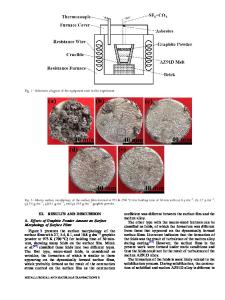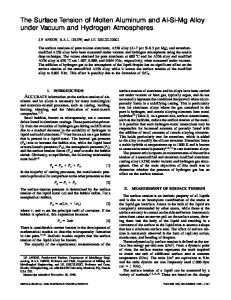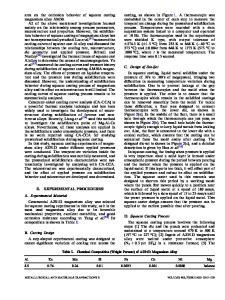Microstructure, Composition, and Depth Analysis of Surface Films Formed on Molten AZ91D Alloy under Protection of SF 6 M
- PDF / 465,966 Bytes
- 7 Pages / 594 x 792 pts Page_size
- 94 Downloads / 258 Views
MOLTEN magnesium oxidizes rapidly during casting and handling. Because of this, a cover gas is required, and both SO2 and SF6, mixed with N2, CO2, or dry air are the most common methods used to protect molten magnesium. Recently, the use of SF6 has become more and more restricted, because of its expensive price and environmental issues. Studying the protective mechanism of SF6 is very important for finding replacements. Some investigations have been started, but the protective mechanism of SF6 is still not very clear and requires further study. Couling[1,2] studied the protection of pure magnesium and the AZ91B alloy in atmospheres containing SF6. He found that SF6 was consumed during the experiments and attributed this to the adsorption of SF6 to an MgO surface or reaction to form MgF2. Recently, Cashion[3–5] used several kinds of techniques to study the surface films formed during controlled exposure of molten magnesium. He found that the films consisted of MgO and MgF2; the amount of fluoride increased with increasing concentration of SF6 in the range of 0.1 to 1 pct. He also found that the thickness of the films increases with the increase of the protective time. These results were partly confirmed by Pettersen et al.[6] In Pettersen’s experiments, little sulfur was found when the melt was protected by SO2, while fluoride was the only element detected in the oxide when SHOU-MEI XIONG and XIAO-LONG LIU are with the Key Laboratory for Advanced Materials Processing Technology, Ministry of Education, Department of Mechanical Engineering, Tsinghua University, Beijing 100084, P.R. China. Contact e-mail: smxiong@ tsinghua.edu.cn Manuscript submitted April 3, 2006. 428—VOLUME 38A, FEBRUARY 2007
SF6 or other fluoride-containing gases were used for protection. Aarstad[7] used various techniques to study the surface of magnesium protected by SF6. He found that the thickness of the film varied between 0.3 and 1 lm, increasing with the increase of the melting temperature and holding time. Large spots containing MgF2 may form on the interface between the oxide film and the bulk magnesium. These spots grew until they covered 25 to 50 pct of the total surface area.
II.
EXPERIMENTAL METHODS
A. Apparatus Figure 1 shows a schematics diagram of the apparatus. A stainless steel melting pot was located in the furnace. A silicon control temperature controller was used to adjust the temperature of the melt (error band
Data Loading...











